TP Link WDR3500 Manual

TL-WDR3500
N600 Wireless Dual Band Router
Rev: 1.0.0 1910010688
COPYRIGHT & TRADEMARKS
Specifications are subject to change without notice.  is a registered trademark of TP-LINK TECHNOLOGIES CO., LTD. Other brands and product names are trademarks or registered trademarks of their respective holders.
is a registered trademark of TP-LINK TECHNOLOGIES CO., LTD. Other brands and product names are trademarks or registered trademarks of their respective holders.
No part of the specifications may be reproduced in any form or by any means or used to make any derivative such as translation, transformation, or adaptation without permission from TP-LINK TECHNOLOGIES CO., LTD. Copyright © 2012 TP-LINK TECHNOLOGIES CO., LTD. All rights reserved.
http://www.tp-link.com

FCC STATEMENT
This equipment has been tested and found to comply with the limits for a Class B digital device, pursuant to part 15 of the FCC Rules. These limits are designed to provide reasonable protection against harmful interference in a residential installation. This equipment generates, uses and can radiate radio frequency energy and, if not installed and used in accordance with the instructions, may cause harmful interference to radio communications. However, there is no guarantee that interference will not occur in a particular installation. If this equipment does cause harmful interference to radio or television reception, which can be determined by turning the equipment off and on, the user is encouraged to try to correct the interference by one or more of the following measures:
Reorient or relocate the receiving antenna.
Increase the separation between the equipment and receiver.
Connect the equipment into an outlet on a circuit different from that to which the receiver is connected.
Consult the dealer or an experienced radio/ TV technician for help.
This device complies with part 15 of the FCC Rules. Operation is subject to the following two conditions:
This device may not cause harmful interference.
This device must accept any interference received, including interference that may cause undesired operation.
Any changes or modifications not expressly approved by the party responsible for compliance could void the user’s authority to operate the equipment.
Note: The manufacturer is not responsible for any radio or TV interference caused by unauthorized modifications to this equipment. Such modifications could void the user’s authority to operate the equipment.
FCC RF Radiation Exposure Statement:
This equipment complies with FCC RF radiation exposure limits set forth for an uncontrolled environment. This device and its antenna must not be co-located or operating in conjunction with any other antenna or transmitter.
“To comply with FCC RF exposure compliance equirements,r this grant is applicable to only Mobile Configurations. The antennas used for this transmitter must be installed to provide a separation distance of at least 20 cm from all persons and must not be co-located or operating in conjunction with any other antenna or transmitter.”
Note Operations in the 5.15-5.25GHz band are restricted to indoor usage only.

CE Mark Warning
This is a class B product. In a domestic environment, this product may cause radio interference, in which case the user may be required to take adequate measures.
National Restrictions
This device is intended for home and office use in all EU countries (and other countries following the EU directive 1999/5/EC) without any limitation except for the countries mentioned below:
Country |
Restriction |
Reason/remark |
|
|
|
|
|
Bulgaria |
None |
General authorization required for outdoor use and |
|
public service |
|||
|
|
||
|
|
|
|
Italy |
None |
If used outside of own premises, general authorization is |
|
required |
|||
|
|
||
|
|
|
|
Luxembourg |
None |
General authorization required for network and service |
|
supply(not for spectrum) |
|||
|
|
||
|
|
|
|
Norway |
Implemented |
This subsection does not apply for the geographical area |
|
within a radius of 20 km from the centre of Ny-Ålesund |
|||
|
|
||
|
|
|
|
Russian Federation |
None |
Only for indoor applications |
|
|
|
|
This device has been designed to operate with the antennas listed below, and having a maximum gain of 3dBi. Antennas not included in this list or having a gain greater than 3dBi are strictly prohibited for use with this device. The required antenna impedance is 50 ohms.
To reduce potential radio interference to other users, the antenna type and its gain should be so chosen that the equivalent isotropically radiated power (e.i.r.p.) is not more than that permitted for successful communication.
Industry Canada Statement:
This device complies with RSS-210 of the Industry Canada Rules. Operation is subject to the following two conditions:
(1)This device may not cause harmful interference, and

(2)This device must accept any interference received, including interference that may cause undesired operation.
IMPORTANT NOTE:
Radiation Exposure Statement:
This equipment complies with Canada radiation exposure limits set forth for an uncontrolled environment. This equipment should be installed and operated with minimum distance 20cm between the radiator & your body.
Ce dispositif est conforme à la norme CNR-210 d’Industrie Canada applicable aux appareils radio exempts de licence. Son fonctionnement est sujet aux deux conditions suivantes:
(1)Le dispositif ne doit pas produire de brouillage préjudiciable, et
(2)Ce dispositif doit accepter tout brouillage reçu,y compris un brouillage susceptible de provoquer un fonctionnement indésirable.
NOTE IMPORTANTE:
Déclaration d’exposition aux radiations:
Cet équipement est conforme aux limites d’exposition aux rayonnements IC établies pour un environnement non contrôlé. Cet équipement doit être installé et utilisé avec un minimum de 20 cm de distance entre la source de rayonnement et votre corps.
Korea Warning Statements:
.
NCC Notice:
率或變更原設計之特性及功能。
機須忍受合法通信或工業、科學及醫療用電波輻射性電機設備之干擾。
Продукт сертифіковано згідно с правилами системи УкрСЕПРО на відповідність вимогам нормативних документів та вимогам, що передбачені чинними законодавчими актами України.

TP-LINK TECHNOLOGIES CO., LTD
DECLARATION OF
 CONFORMITY
CONFORMITY
For the following equipment:
Product Description: N600 Wireless Dual Band Router
Model No.: TL-WDR3500
Trademark: TP-LINK
We declare under our own responsibility that the above products satisfy all the technical regulations applicable to the product within the scope of Council Directives:
Directives 1999/5/EC, Directives 2004/108/EC, Directives 2006/95/EC, Directives 1999/519/EC, Directives 2011/65/EU
The above product is in conformity with the following standards or other normative documents ETSI EN 300 328 V1.7.1: 2006
ETSI EN 301 489-1 V1.9.2:2008& ETSI EN 301 489-17 V2.1.1:2009 EN 301 893 V1.6.1:2011
EN 55022:2010
EN 55024:2010
EN 61000-3-2:2006+A1:2009+A2:2009 EN 61000-3-3:2008
EN60950-1:2006+A11:2009+A1:2010+A12:2011
EN62311:2008
EN62075:2008 IEC/PAS62596, IEC62321
The product carries the CE Mark:
Person is responsible for marking this declaration:
Yang Hongliang
Product Manager of International Business
Date of issue: 2012
TP-LINK TECHNOLOGIES CO., LTD.
Building 24 (floors 1, 3, 4, 5), and 28 (floors 1-4) Central Science and Technology Park,
Shennan Rd, Nanshan, Shenzhen, China
|
|
CONTENTS |
|
Package Contents..................................................................................................... |
1 |
||
Chapter 1. Introduction......................................................................................... |
2 |
||
1.1 |
Overview of the Router............................................................................................... |
2 |
|
1.2 |
Conventions ............................................................................................................... |
3 |
|
1.3 |
Main Features ............................................................................................................ |
3 |
|
1.4 |
Panel Layout .............................................................................................................. |
4 |
|
|
1.4.1 |
The Front Panel.............................................................................................. |
4 |
|
1.4.2 |
The Rear Panel .............................................................................................. |
5 |
Chapter 2. Connecting the Router ....................................................................... |
7 |
||
2.1 |
System Requirements ................................................................................................ |
7 |
|
2.2 |
Installation Environment Requirements...................................................................... |
7 |
|
2.3 |
Connecting the Router ............................................................................................... |
7 |
|
Chapter 3. Quick Installation Guide..................................................................... |
9 |
||
3.1 |
TCP/IP Configuration ................................................................................................. |
9 |
|
3.2 |
Quick Installation Guide ........................................................................................... |
10 |
|
Chapter 4. Configuring the Router .................................................................... |
19 |
||
4.1 |
Login ........................................................................................................................ |
|
19 |
4.2 |
Status ....................................................................................................................... |
|
19 |
4.3 |
Quick Setup.............................................................................................................. |
20 |
|
4.4 |
Network .................................................................................................................... |
21 |
|
|
4.4.1 |
WAN ............................................................................................................. |
21 |
|
4.4.2 |
LAN .............................................................................................................. |
30 |
|
4.4.3 |
MAC Clone ................................................................................................... |
31 |
4.5 |
Dual Band Selection................................................................................................. |
32 |
|
4.6 |
Wireless 2.4GHz ...................................................................................................... |
33 |
|
|
4.6.1 |
Wireless Settings.......................................................................................... |
33 |
|
4.6.2 |
WPS ............................................................................................................. |
35 |
|
4.6.3 |
Wireless Security.......................................................................................... |
38 |
|
4.6.4 |
Wireless MAC Filtering ................................................................................. |
41 |
|
4.6.5 |
Wireless Advanced ....................................................................................... |
43 |
|
4.6.6 |
Wireless Statistics......................................................................................... |
45 |
4.7 |
Wireless 5GHz ......................................................................................................... |
45 |
|
- I -
|
4.7.1 |
Wireless Settings .......................................................................................... |
46 |
|
4.7.2 |
WPS ............................................................................................................. |
48 |
|
4.7.3 |
Wireless Security .......................................................................................... |
51 |
|
4.7.4 |
Wireless MAC Filtering ................................................................................. |
54 |
|
4.7.5 |
Wireless Advanced ....................................................................................... |
56 |
|
4.7.6 |
Wireless Statistics ......................................................................................... |
57 |
4.8 |
DHCP |
....................................................................................................................... |
57 |
|
4.8.1 ............................................................................................. |
DHCP Settings |
58 |
|
4.8.2 ......................................................................................... |
DHCP Clients List |
59 |
|
4.8.3 .................................................................................... |
Address Reservation |
59 |
4.9 |
USB Settings............................................................................................................ |
61 |
|
|
4.9.1 ............................................................................................ |
Storage Sharing |
61 |
|
4.9.2 ................................................................................................... |
FTP Server |
62 |
|
4.9.3 ................................................................................................ |
Media Server |
64 |
|
4.9.4 ................................................................................................... |
Print Server |
66 |
|
4.9.5 .............................................................................................. |
User Accounts |
67 |
4.10 NAT .......................................................................................................................... |
|
69 |
|
4.11 Forwarding ............................................................................................................... |
69 |
||
|
4.11.1 .............................................................................................. |
Virtual Servers |
69 |
|
4.11.2 .............................................................................................. |
Port Triggering |
71 |
|
4.11.3 ..............................................................................................................DMZ |
73 |
|
|
4.11.4 ............................................................................................................UPnP |
74 |
|
4.12 Security .................................................................................................................... |
75 |
||
|
4.12.1 ...............................................................................................Basic Security |
75 |
|
|
4.12.2 ........................................................................................Advanced Security |
76 |
|
|
4.12.3 .......................................................................................Local Management |
78 |
|
|
4.12.4 ...................................................................................Remote Management |
79 |
|
4.13 Parental .......................................................................................................Control |
80 |
||
4.14 Access .........................................................................................................Control |
82 |
||
|
4.14.1 ..............................................................................................................Rule |
83 |
|
|
4.14.2 ..............................................................................................................Host |
88 |
|
|
4.14.3 ............................................................................................................Target |
90 |
|
|
4.14.4 .......................................................................................................Schedule |
92 |
|
4.15 Advanced ....................................................................................................Routing |
94 |
||
|
4.15.1 .........................................................................................Static Routing List |
94 |
|
|
4.15.2 ...................................................................................System Routing Table |
95 |
|
- II -
4.16 Bandwidth Control .................................................................................................... |
96 |
4.16.1 Control Settings ............................................................................................ |
96 |
4.16.2 Rules List...................................................................................................... |
96 |
4.17 IP & MAC Binding Setting ........................................................................................ |
97 |
4.17.1 Binding Settings............................................................................................ |
98 |
4.17.2 ARP List........................................................................................................ |
99 |
4.18 Dynamic DNS......................................................................................................... |
100 |
4.18.1 Comexe.cn DDNS ...................................................................................... |
100 |
4.18.2 Dyndns.org DDNS ...................................................................................... |
101 |
4.18.3 No-ip.com DDNS ........................................................................................ |
102 |
4.19 System Tools.......................................................................................................... |
103 |
4.19.1 Time Setting................................................................................................ |
104 |
4.19.2 Diagnostic................................................................................................... |
105 |
4.19.3 Firmware Upgrade...................................................................................... |
107 |
4.19.4 Factory Defaults ......................................................................................... |
108 |
4.19.5 Backup & Restore....................................................................................... |
109 |
4.19.6 Reboot........................................................................................................ |
109 |
4.19.7 Password.................................................................................................... |
110 |
4.19.8 System Log................................................................................................. |
110 |
4.19.9 Statistics ..................................................................................................... |
112 |
Appendix A: FAQ .................................................................................................. |
115 |
Appendix B: Configuring the PCs....................................................................... |
120 |
Appendix C: Specifications ................................................................................. |
123 |
Appendix D: Glossary .......................................................................................... |
124 |
- III -

TL-WDR3500 N600 Wireless Dual Band Router
Package Contents
The following items should be found in your package:
TL-WDR3500 N600 Wireless Dual Band Router
DC Power Adapter for TL-WDR3500 N600 Wireless Dual Band Router
Quick Installation Guide
Resource CD for TL-WDR3500 N600 Wireless Dual Band Router, including:
This Guide
Other Helpful Information
Note:
Make sure that the package contains the above items. If any of the listed items are damaged or missing, please contact your distributor.
- 1 -

TL-WDR3500 N600 Wireless Dual Band Router
Chapter 1. Introduction
Thank you for choosing the TL-WDR3500 N600 Wireless Dual Band Router.
1.1Overview of the Router
The TL-WDR3500 N600 Wireless Dual Band Router integrates 4-port Switch, Firewall, NAT-Router and Wireless AP. Powered by 3x3 MIMO technology, the N600 Wireless Dual Band Router delivers exceptional range and speed, which can fully meet the need of Small Office/Home Office (SOHO) networks and the users demanding higher networking performance. Your wireless connections are radio band selectable to avoid interference in your area.
Incredible Speed
The TL-WDR3500 N600 Wireless Dual Band Router provides up to 300Mbps (2.4GHz) + 300Mbps (5GHz) wireless connection with other 802.11n wireless clients. The incredible speed makes it ideal for handling multiple data streams at the same time, which ensures your network stable and smooth. The performance of this 802.11n wireless Router will give you the unexpected networking experience at speed much faster than 802.11g. It is also compatible with all IEEE 802.11g and IEEE 802.11b products.
Multiple Security Protections
With multiple protection measures, including SSID broadcast control and wireless LAN 64/128/152-bit WEP encryption, Wi-Fi Protected Access (WPA2PSK, WPAPSK), as well as advanced Firewall protections, the TL-WDR3500 N600 Wireless Dual Band Router provides complete data privacy.
Flexible Access Control
The TL-WDR3500 N600 Wireless Dual Band Router provides flexible access control, so that parents or network administrators can establish restricted access policies for children or staff. It also supports Virtual Server and DMZ host for Port Triggering, and then the network administrators can manage and monitor the network in real time with the remote management function.
Simple Installation
Since the Router is compatible with virtually all the major operating systems, it is very easy to manage. Quick Setup Wizard is supported and detailed instructions are provided step by step in this user guide. Before installing the Router, please look through this guide to know all the Router’s functions.
- 2 -

TL-WDR3500 N600 Wireless Dual Band Router
1.2Conventions
The Router or TL-WDR3500 mentioned in this guide stands for TL-WDR3500 N600 Wireless Dual Band Router without any explanation.
1.3Main Features
Complies with IEEE 802.11n to provide a wireless data rate of up to 300Mbps (2.4GHz) + 300Mbps (5GHz).
One 10/100M Auto-Negotiation RJ45 Internet port, four 10/100M Auto-Negotiation RJ45 Ethernet ports, supporting Auto MDI/MDIX.
Provides USB port supporting storage/FTP/Media/Print Server.
Provides WPA/WPA2, WPA-PSK/WPA2-PSK authentication, TKIP/AES encryption security.
Shares data and Internet access for users, supporting Dynamic IP/Static IP/PPPoE Internet access.
Works in 2.4GHz or 5GHz radio bands, doubling your network capability.
Supports Virtual Server, Special Application and DMZ host.
Supports UPnP, Dynamic DNS, Static Routing.
Provides Automatic-connection and Scheduled Connection on certain time to the Internet.
Built-in NAT and DHCP server supporting static IP address distributing.
Supports Parental Control and Access Control.
Connects Internet on demand and disconnects from the Internet when idle for PPPoE.
Provides 64/128/152-bit WEP encryption security and wireless LAN ACL (Access Control List).
Supports Flow Statistics.
Supports firmware upgrade and Web management.
- 3 -
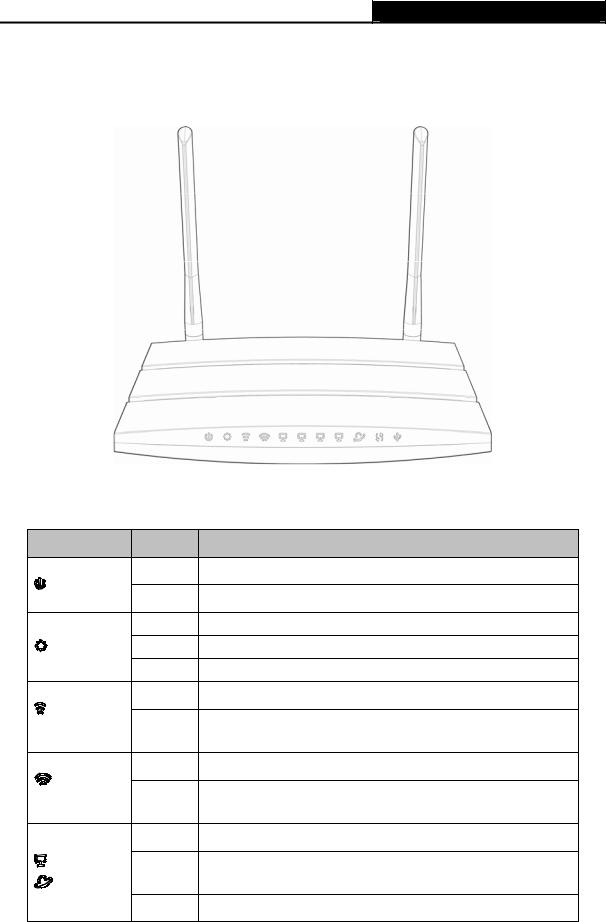
TL-WDR3500 N600 Wireless Dual Band Router
1.4Panel Layout
1.4.1The Front Panel
|
|
Figure 1-1 LEDs on the front panel |
|
The Router’s LEDs are located on the front panel (View from left to right). |
|||
Name |
Status |
Indication |
|
(Power) |
Off |
Power is off. |
|
On |
Power is on. |
||
|
|||
|
On |
The Router is initializing or maybe has a system error. |
|
(System) |
Flashing |
The Router is working properly. |
|
|
Off |
The Router has a system error. |
|
(Wireless |
Off |
The wireless function is disabled. |
|
|
The wireless function is enabled. The Router is working on |
||
2.4GHz) |
Flashing |
||
|
2.4GHz radio band. |
||
(Wireless |
Off |
The wireless function is disabled. |
|
|
The wireless function is enabled. The Router is working on |
||
5GHz) |
Flashing |
||
|
5GHz radio band. |
||
|
Off |
There is no device linked to the corresponding port. |
|
(Ethernet) |
On |
There is a device linked to the corresponding port but there |
|
(Internet) |
is no activity. |
||
|
|||
|
Flashing |
There is an active device linked to the corresponding port. |
|
- 4 -

|
|
|
|
TL-WDR3500 |
N600 Wireless Dual Band Router |
|
|
|
|
|
|
|
|
|
|
|
Slow |
A wireless device is connecting to the network by WPS |
|
|
|
|
|
Flash |
function. This process will last in the first 2 minutes. |
|
|
|
|
|
|
|
|
|
|
|
(WPS) |
On |
A wireless device has been successfully added to the |
|
|
|
|
network by WPS function. |
|
|||
|
|
|
|
|
||
|
|
|
|
|
|
|
|
|
|
Quick |
A wireless device failed to be added to the network by WPS |
|
|
|
|
|
Flash |
function. |
|
|
|
|
|
|
|
|
|
|
|
(USB) |
Off |
No storage device or printer is plugged into the USB port. |
|
|
|
|
|
|
|
|
|
|
|
On |
A storage device or printer has connected to the USB port. |
|
||
|
|
|
|
|||
|
|
|
|
|
|
|
Table 1-1 The LEDs Description
Note:
1)After a device is successfully added to the network by WPS function, the WPS LED will keep on for about 5 minutes and then turn off.
2)The Router is set to working concurrently in 2.4GHz and 5GHz by default. If you desire to choose the working frequency, please go to 4.5 Dual Band Selection.
1.4.2The Rear Panel
Figure 1-2 Rear Panel sketch
The following parts are located on the rear panel (View from left to right).
Power: The Power socket is where you will connect the power adapter. Please use the power adapter provided with this TL-WDR3500 N600 Wireless Dual Band Router.
On/Off: The switch for the power.
Wireless On/Off: The switch for the wireless function.
USB: The USB port connects to a USB storage device or a USB printer.
Internet: This port is where you will connect the DSL/cable Modem, or Ethernet.
-5 -

TL-WDR3500 N600 Wireless Dual Band Router
Ethernet (1, 2, 3, 4): These ports (1, 2, 3, 4) connect the Router to the local PC(s).
WPS/Reset:
Pressing this button for less than 5 seconds enables the WPS function. If your client devices, such as wireless adapters, that support Wi-Fi Protected Setup, then you can press this button to quickly establish a connection between the Router and client devices and automatically configure wireless security for your wireless network.
Pressing this button for more than 5 seconds enables the Reset function. With the Router powered on, press and hold the WPS/Reset button (approximately 8 seconds) until the SYS LED becomes quick-flash from slow-flash. And then release the button and wait the Router to reboot to its factory default settings.
Wireless antenna: To receive and transmit the wireless data.
- 6 -

TL-WDR3500 N600 Wireless Dual Band Router
Chapter 2. Connecting the Router
2.1System Requirements
Broadband Internet Access Service (DSL/Cable/Ethernet)
One DSL/Cable Modem that has an RJ45 connector (which is not necessary if the Router is connected directly to the Ethernet)
PCs with a working Ethernet Adapter and an Ethernet cable with RJ45 connectors
TCP/IP protocol on each PC
Web browser, such as Microsoft Internet Explorer, Mozilla Firefox or Apple Safari
2.2Installation Environment Requirements
Place the Router in a well ventilated place far from any heater or heating vent
Avoid direct irradiation of any strong light (such as sunlight)
Keep at least 2 inches (5 cm) of clear space around the Router
Operating Temperature: 0 ~40 (32 ~104 )
Operating Humidity: 10%~90%RH, Non-condensing
2.3Connecting the Router
Before installing the Router, make sure your PC is connected to the Internet through the broadband service successfully. If there is any problem, please contact your ISP. After that, please install the Router according to the following steps. Don't forget to pull out the power plug and keep your hands dry.
1.Power off your Cable/DSL Modem, and the Router.
2.Locate an optimum location for the Router. The best place is usually at the center of your wireless network.
3.Adjust the direction of the antenna. Normally, upright is a good direction.
4.Connect the DSL/Cable Modem to the Internet port of the Router, shown in Figure 2-1.
5.Connect the PC(s) and each Switch/Hub in your LAN to the Ethernet ports on the Router, shown in Figure 2-1. If you have the wireless NIC and want to use the wireless function, you can skip this step.
-7 -
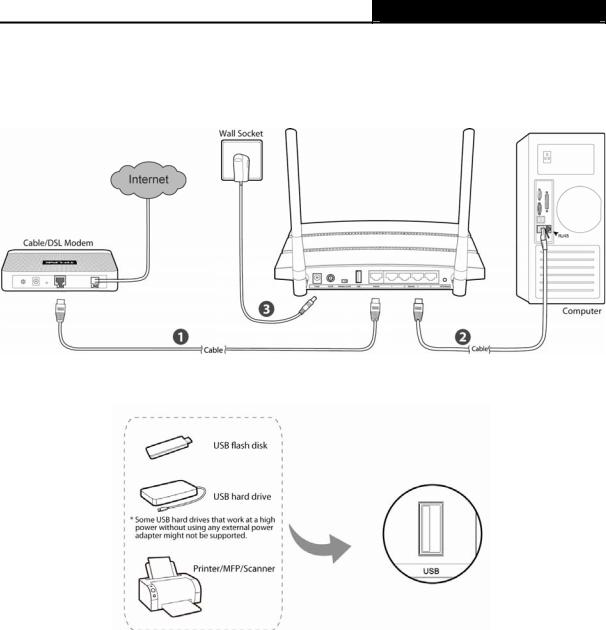
TL-WDR3500 N600 Wireless Dual Band Router
6.Connect the power adapter to the power socket on the Router, and the other end into an electrical outlet, shown in Figure 2-1. The Router will start to work automatically.
7.Power on your Cable/DSL Modem.
Figure 2-1 Hardware Installation
Figure 2-2 USB Installation
Note:
If you want to use the Router to share files or printer, plug the USB storage device to the USB port or connect the printer to the Router with a matching cable.
- 8 -
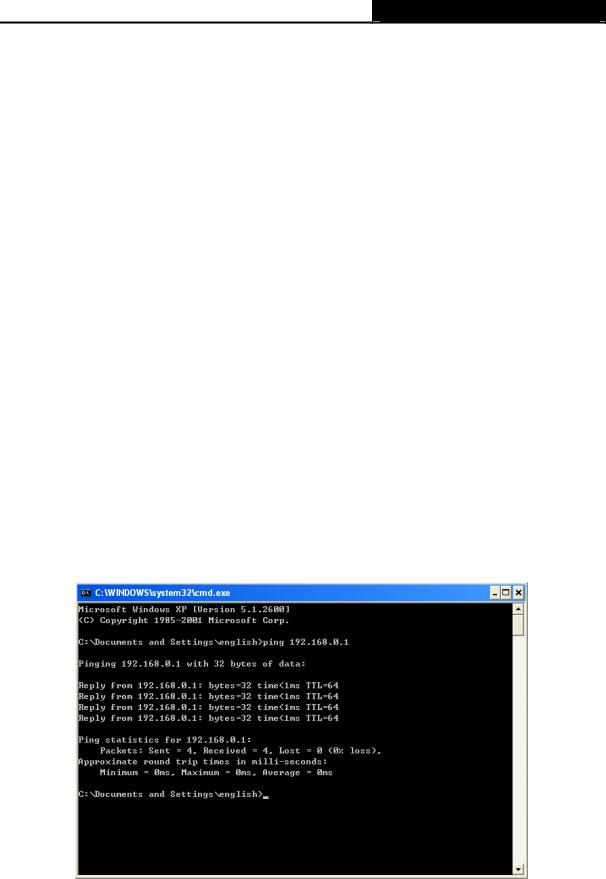
TL-WDR3500 N600 Wireless Dual Band Router
Chapter 3. Quick Installation Guide
This chapter will show you how to configure the basic functions of your N600 Wireless Dual Band Router using Quick Setup Wizard within minutes.
3.1TCP/IP Configuration
The default IP address of the Router is 192.168.0.1 and the default Subnet Mask is 255.255.255.0. These values can be changed as you desire. In this guide, we use all the default values for description.
Connect the local PC to the Ethernet ports of the Router and then you can configure the IP address for your PC by the following method: Set up the TCP/IP Protocol in "Obtain an IP address automatically" mode on your PC. If you need instructions as to how to do this, please refer to Appendix B: Configuring the PC. Then the built-in DHCP server will assign IP address for the PC.
Now, you can run the Ping command in the command prompt to verify the network connection between your PC and the Router. The following example is in Windows 2000 OS.
Open a command prompt, and type ping 192.168.0.1, and then press Enter.
If the result displayed is similar to the Figure 3-1, it means the connection between your PC and the Router has been established well.
Figure 3-1 Success result of Ping command
If the result displayed is similar to Figure 3-2, it means the connection between your PC and the Router failed.
-9 -
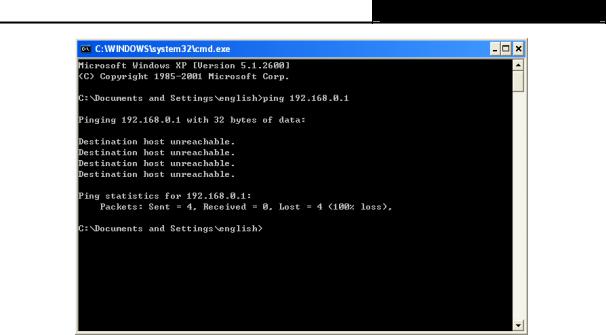
TL-WDR3500 N600 Wireless Dual Band Router
Figure 3-2 Failure result of Ping command
Please check the connection following these steps:
1.Is the connection between your PC and the Router correct?
Note:
The 1/2/3/4 LEDs of Ethernet ports which you link to on the Router and LEDs on your PC's adapter should be lit.
2.Is the TCP/IP configuration for your PC correct?
Note:
If the Router's IP address is 192.168.0.1, your PC's IP address must be within the range of 192.168.0.2 ~ 192.168.0.254.
3.Is the default LAN IP of the Router correct?
Note:
If the LAN IP of the modem connected with your router is 192.168.0.x, the default LAN IP of the Router will automatically switch from 192.168.0.1 to 192.168.1.1 to avoid IP conflict. Therefore, in order to verify the network connection between your PC and the Router, you can open a command prompt, and type ping 192.168.1.1, and then press Enter.
3.2Quick Installation Guide
With a Web-based utility, it is easy to configure and manage the N600 Wireless Dual Band Router. The Web-based utility can be used on any Windows, Macintosh or UNIX OS with a Web browser, such as Microsoft Internet Explorer, Mozilla Firefox or Apple Safari.
1.To access the configuration utility, open a web-browser and type in the default IP address http://tplinklogin.net in the address field.
-10 -
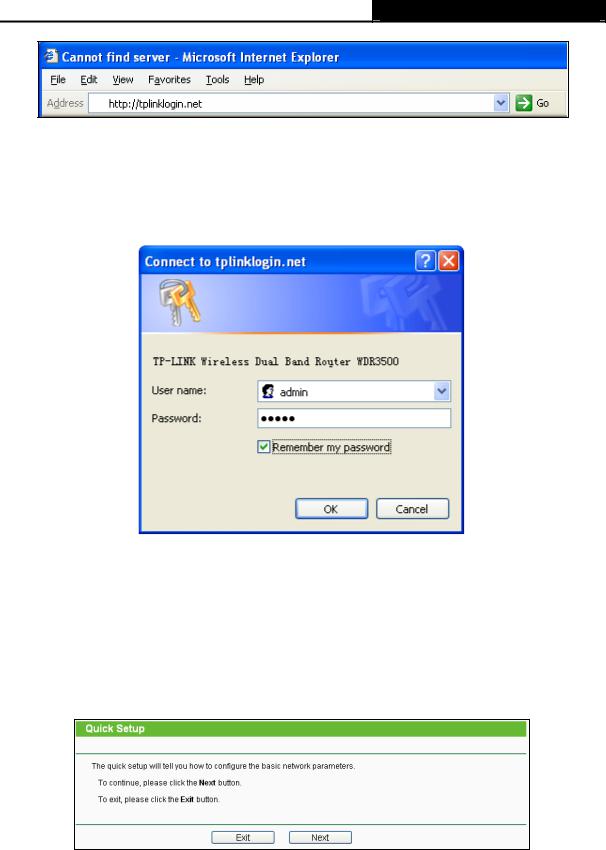
TL-WDR3500 N600 Wireless Dual Band Router
Figure 3-3 Log in the Router
After a moment, a login window will appear, similar to Figure 3-4. Enter admin for the User Name and Password, both in lower case letters. Then click the OK button or press the Enter key.
Figure 3-4 Login Windows
Note:
If the above screen does not pop up, it means that your Web-browser has been set to a proxy. Go to Tools menu>Internet Options>Connections>LAN Settings, in the screen that appears, cancel the Using Proxy checkbox, and click OK to finish it.
2.After successful login, you can click the Quick Setup menu to quickly configure your Router.
Figure 3-5 Quick Setup
3.Click Next, and then WAN Connection Type page will appear, shown in Figure 3-6. The Router provides Auto-Detect function and supports three popular ways Dynamic IP, Static IP and PPPoE to connect to the Internet. It’s recommended that you make use of the
-11 -
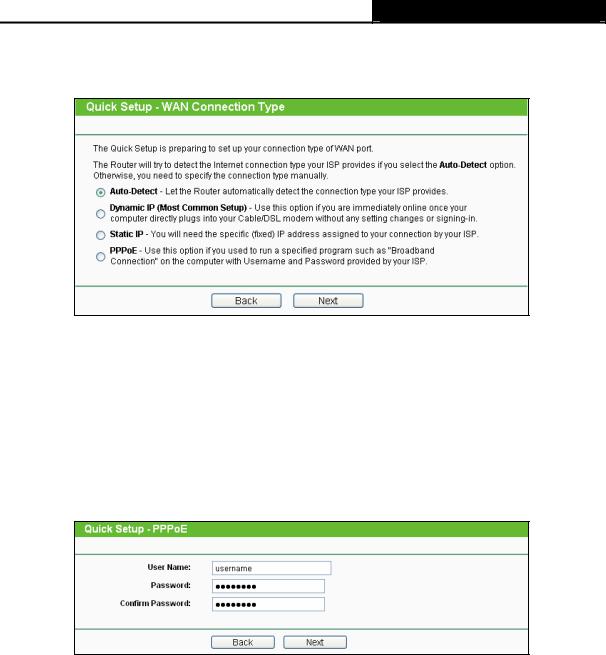
TL-WDR3500 N600 Wireless Dual Band Router
Auto-Detect function. If you are sure of what kind of connection type your ISP provides, you can select the very type and click Next to go on configuring.
Figure 3-6 WAN Connection Type
4.If you select Auto-Detect, the Router will automatically detect the connection type your ISP provides. Make sure the cable is securely plugged into the Internet port before detection. The appropriate configuration page will be displayed when an active Internet service is successfully detected by the Router.
1)If the connection type detected is PPPoE, the next screen will appear as shown in Figure 3-7.
Figure 3-7 Quick Setup - PPPoE
User Name/Password - Enter the User Name and Password provided by your ISP. These fields are case-sensitive. If you have difficulty with this process, please contact your ISP.
Confirm Password - Enter the password again to make sure that the password is correct.
2)If the connection type detected is Dynamic IP, the next screen will appear as shown in Figure 3-8. A MAC address is a 12-digit code assigned to a unique piece of hardware for identification. Some ISPs will register the MAC address of your computer when you access the Internet for the first time via the cable/ADSL modem they offered. If you add a router into your network to share the Internet, the ISP may not recognize the new MAC
-12 -
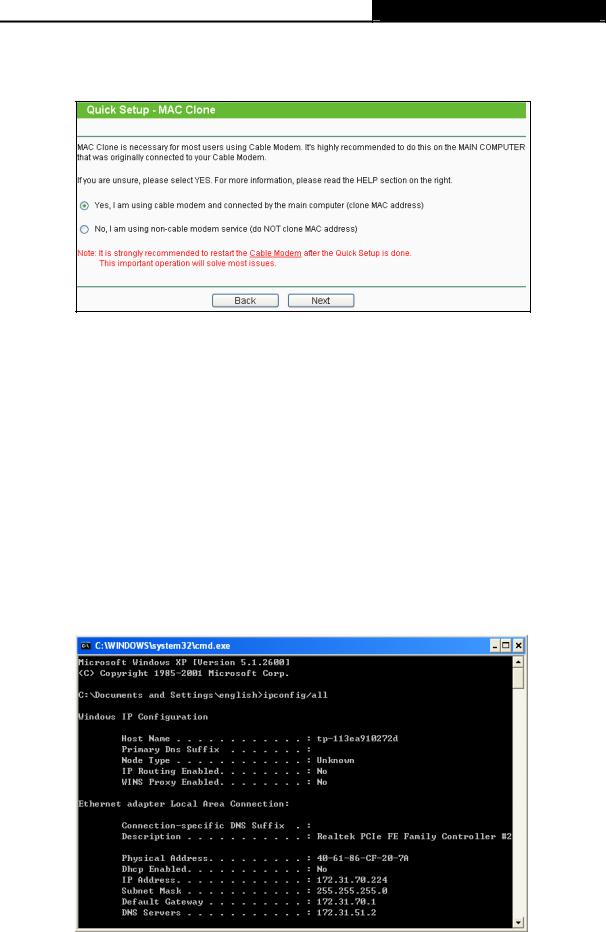
TL-WDR3500 N600 Wireless Dual Band Router
address of the router and will not offer the Internet connection any more. Therefore, it is necessary to clone the MAC address of the computer to the router.
Figure 3-8 Quick Setup – MAC Clone
If you are visiting the Router from the main computer, please select Yes, and then click
Next.
If you are visiting the Router from another computer rather than the main computer, please select No, and then click Next.
Note:
1)It’s strongly recommended that you visit and configure the Router from the main computer.
2)To find the main computer’s MAC, please go to Start > Run on your main computer, type in cmd and press Enter. At the command prompt, enter ipconfig/all and press Enter. The MAC will be displayed as Physical Address, shown in Figure 3-9.
Figure 3-9 Find MAC Address
- 13 -
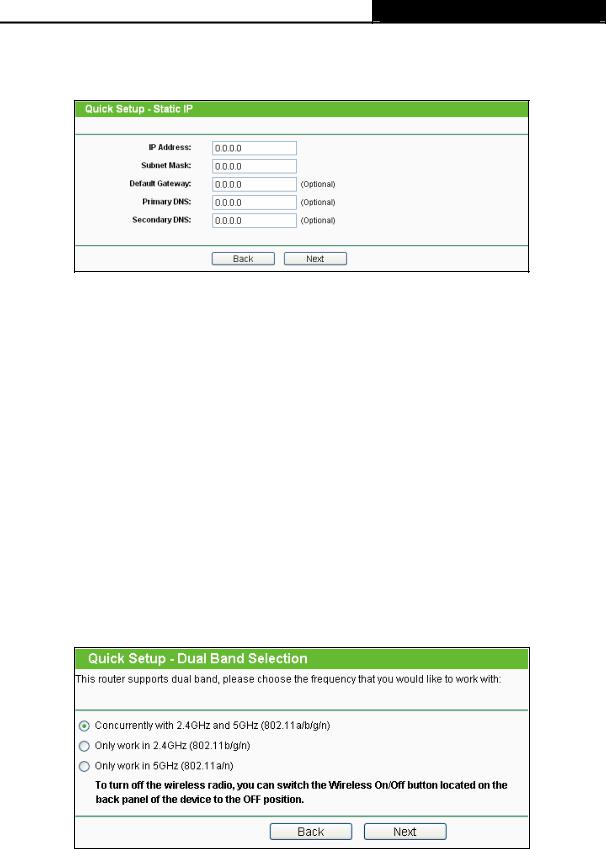
TL-WDR3500 N600 Wireless Dual Band Router
3)If the connection type detected is Static IP, the next screen will appear as shown in Figure 3-10. Configure the following parameters and then click Next to continue.
Figure 3-10 Quick Setup - Static IP
IP Address - This is the WAN IP address as seen by external users on the Internet (including your ISP). Your ISP will provide you with the IP address you need to enter here. Enter the IP address into the field.
Subnet Mask - The Subnet Mask is used for the WAN IP address. Your IPS will provide you with the subnet mask which is usually 255.255.255.0.
Default Gateway - Your ISP will provide you with the Gateway address which is the ISP server’s address. Enter the gateway IP address into the box if required.
Primary DNS - Enter the DNS Server IP address into the box if required.
Secondary DNS - If your ISP provides another DNS server, enter it into this field.
5.After finishing WAN Connection Type selection, the Dual Band Selection page will appear as shown in Figure 3-11. Here we choose “Concurrently with 2.4GHz and 5GHz (802.11a/b/g/n)” for introduction. Click Next to continue.
Figure 3-11 Quick Setup – Dual Band Selection
2.4GHz - You can use the 2.4GHz band to connect to many classic wireless devices like gaming consoles, laptops, DVRs, ect.
-14 -
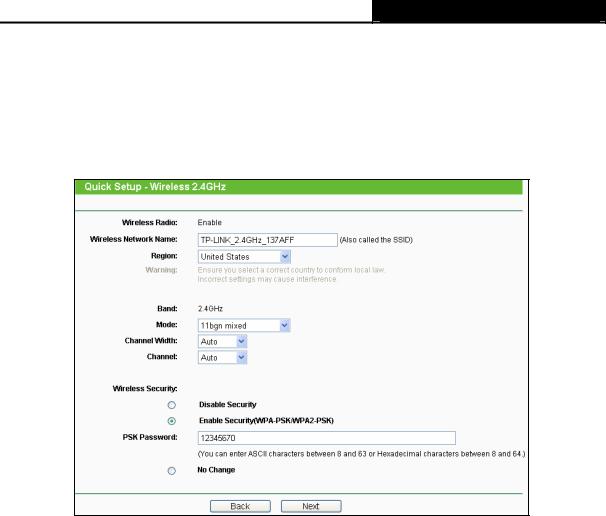
TL-WDR3500 N600 Wireless Dual Band Router
5GHz - This band is less crowded and is used for time-sensitive music, video streaming or gaming. Using this band can avoid interference with 2.4GHz networks or noisy devices like cordless phones and microwave ovens.
6.Configure the basic parameters for 2.4GHz wireless network in the following screen as shown in Figure 3-12, and then click Next.
Figure 3-12 Quick Setup – Wireless
Wireless Radio - Displays whether the wireless function is enabled or not.
Wireless Network Name - Also called the SSID (Service Set Identification). Enter a value of up to 32 characters. The same name must be assigned to all wireless devices in your network. The default SSID is set to be TP-LINK_2.4GHz_XXXXXX. This value is case-sensitive. For example, TEST is NOT the same as test.
Region - Select your region from the drop-down list. This field specifies the region where the wireless function of the Router can be used. It may be illegal to use the wireless function of the Router in a region other than one of those specified in this field. If your country or region is not listed, please contact your local government agency for assistance.
Note:
Limited by local law regulations, version for North America does not have region selection option.
Band - This field displayed the operating frequency being configured.
Mode - This field determines the wireless mode which the Router works on.
-15 -

TL-WDR3500 N600 Wireless Dual Band Router
11b only - Select if all of your wireless clients are 802.11b.
11g only - Select if all of your wireless clients are 802.11g.
11n only- Select only if all of your wireless clients are 802.11n.
11bg mixed - Select if you are using both 802.11b and 802.11g wireless clients.
11bgn mixed - Select if you are using a mix of 802.11b, 11g, and 11n wireless clients.
Channel Width - Select any channel width from the drop-down list. The default setting is “Auto”, which can adjust the channel width for your clients automatically.
Channel - This field determines which operating frequency will be used. It is not necessary to change the wireless channel unless you notice interference problems with another nearby access point. If you select “Auto”, then the AP will select the best channel automatically.
Wireless Security
Disable Security - The wireless security function can be enabled or disabled. If disabled, the wireless stations will be able to connect the Router without encryption.
Enable Security (WPA-PSK/WPA2-PSK) – It’s selected by default, with the default PSK password the same as the default PIN code.
No Change - If you chose this option, wireless security configuration will not change!
These settings are only for basic wireless parameters. For advanced settings, please refer to 4.6 Wireless 2.4GHz.
7.Configure the basic parameters for 5GHz wireless network in the following screen as shown in Figure 3-13, and then click Next.
- 16 -
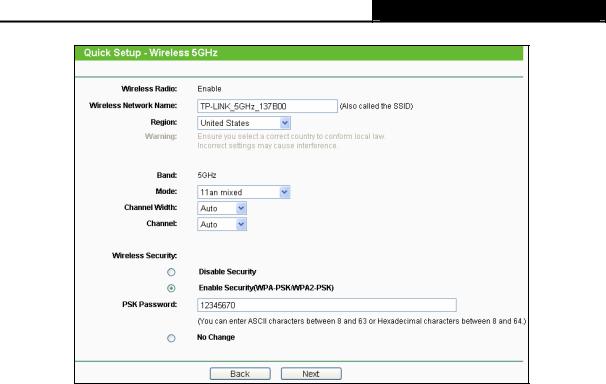
TL-WDR3500 N600 Wireless Dual Band Router
Figure 3-13 Quick Setup – Wireless
Wireless Radio - Choose from the drop-down list to enable or disable the wireless radio.
Wireless Network Name - Also called the SSID (Service Set Identification). Enter a value of up to 32 characters. The same name must be assigned to all wireless devices in your network. The default SSID is set to be TP-LINK_5GHz_XXXXXX. This value is case-sensitive. For example, TEST is NOT the same as test.
Region - Select your region from the drop-down list. This field specifies the region where the wireless function of the Router can be used. It may be illegal to use the wireless function of the Router in a region other than one of those specified in this field. If your country or region is not listed, please contact your local government agency for assistance.
Note:
Limited by local law regulations, version for North America does not have region selection option.
Band - This field displayed the operating frequency being configured.
Mode - This field determines the wireless mode which the Router works on.
11a only - Select if all of your wireless clients are 802.11a.
11n only- Select only if all of your wireless clients are 802.11n.
11an mixed - Select if you are using both 802.11a and 802.11n wireless clients.
-17 -
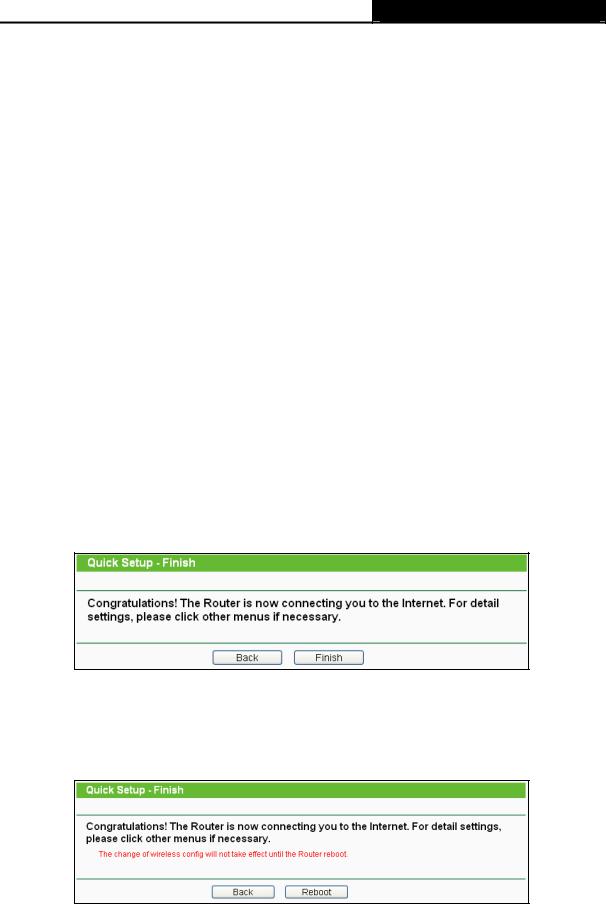
TL-WDR3500 N600 Wireless Dual Band Router
Channel Width - Select any channel width from the drop-down list. The default setting is “Auto”, which can adjust the channel width for your clients automatically.
Channel - This field determines which operating frequency will be used. It is not necessary to change the wireless channel unless you notice interference problems with another nearby access point. If you select “Auto”, then the AP will select the best channel automatically.
Wireless Security
Disable Security - The wireless security function can be enabled or disabled. If disabled, the wireless stations will be able to connect the Router without encryption.
Enable Security (WPA-PSK/WPA2-PSK) – It’s selected by default, with the default PSK password the same as the default PIN code.
No Change - If you chose this option, wireless security configuration will not change!
These settings are only for basic wireless parameters. For advanced settings, please refer to 4.7 Wireless 5GHz.
8.Then you will see the Finish page.
If you don’t make any change on the Wireless page, you will see the Finish page as shown in Figure 3-14. Click the Finish button to finish the Quick Setup.
Figure 3-14 Quick Setup - Finish
If there is anything changed on the Wireless page, you will see the Finish page as shown in Figure 3-15. Click the Reboot button to make your wireless configuration take effect and finish the Quick Setup.
Figure 3-15 Quick Setup – Finish
- 18 -
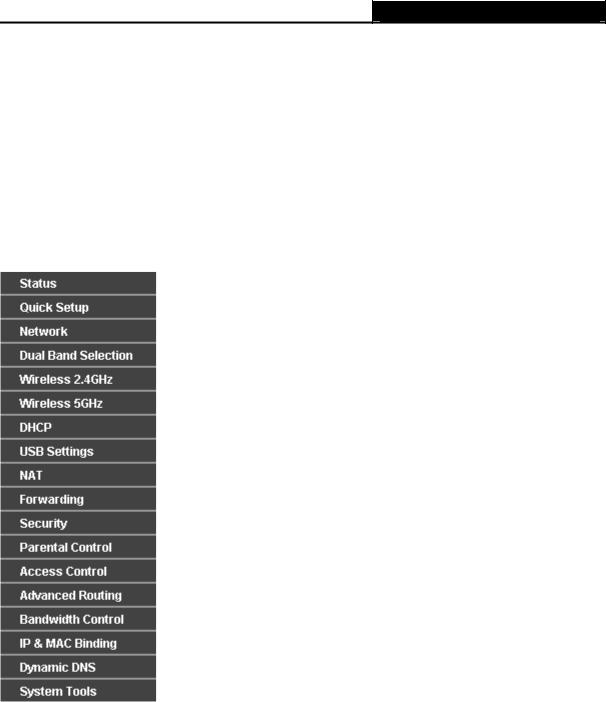
TL-WDR3500 N600 Wireless Dual Band Router
Chapter 4. Configuring the Router
This chapter will show each Web page's key functions and the configuration way.
4.1Login
After your successful login, you will see the sixteen main menus on the left of the Web-based utility. On the right, there are the corresponding explanations and instructions.
The detailed explanations for each Web page’s key function are listed below.
4.2Status
The Status page provides the current status information about the Router. All information is read-only.
- 19 -
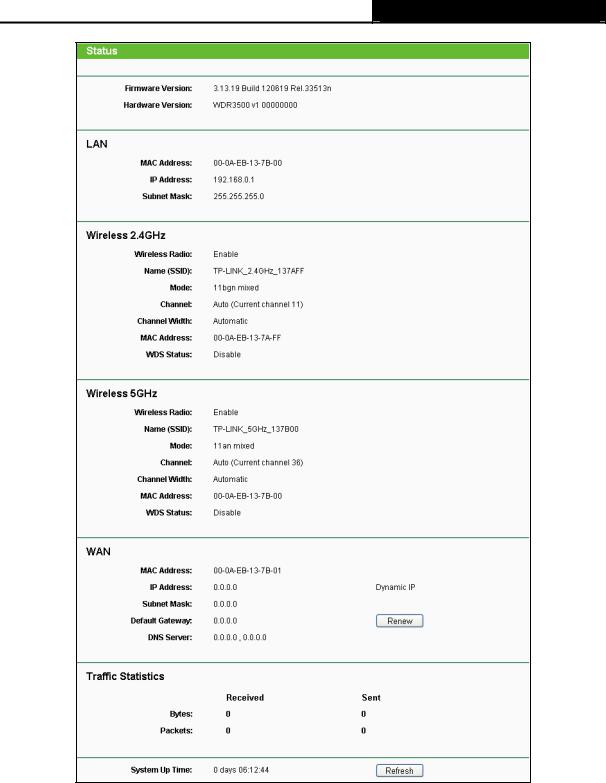
TL-WDR3500 N600 Wireless Dual Band Router
Figure 4-1 Router Status
4.3Quick Setup
Please refer to 3.2 Quick Installation Guide.
- 20 -
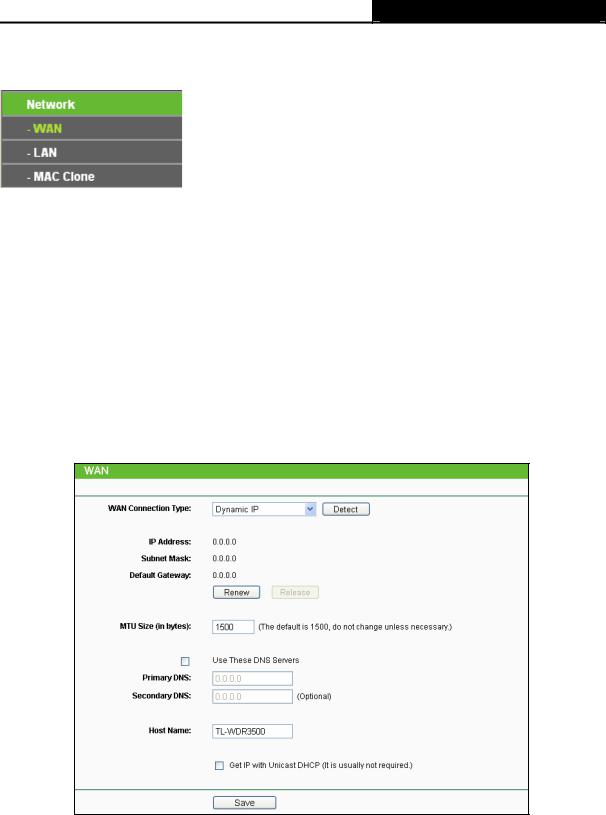
TL-WDR3500 N600 Wireless Dual Band Router
4.4Network
Figure 4-2 the Network menu
There are three submenus under the Network menu (shown in Figure 4-2): WAN, LAN and MAC Clone. Click any of them, and you will be able to configure the corresponding function.
4.4.1WAN
Choose menu “Network → WAN”, you can configure the IP parameters of the WAN on the screen below.
1.If your ISP provides the DHCP service, please choose Dynamic IP type, and the Router will automatically get IP parameters from your ISP. You can see the page as follows (Figure 4-3):
Figure 4-3 WAN – Dynamic IP
This page displays the WAN IP parameters assigned dynamically by your ISP, including IP address, Subnet Mask, Default Gateway, etc. Click the Renew button to renew the IP parameters from your ISP. Click the Release button to release the IP parameters.
- 21 -
